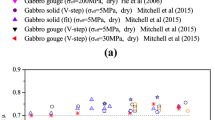Abstract
Layers of artificial granite gouge have been deformed on saw-cut granite surfaces inclined 30° to the sample axes. Samples were deformed at a constant confining pressure of 250 MPa and temperatures of 22 to 845°C. The velocity dependence of the steady-state coefficient of friction (μss) was determined by comparing sliding strengths at different sliding rates. The results of these measurements are consistent with those reported bySolberg andByerlee (1984) at room temperature andStesky (1975) between 300 and 400°C. Stesky found that the slip-rate dependence of (μss) increased above 400°C. In the present study, however, the velocity dependence of (μss) was nearly independent of temperature.
Similar content being viewed by others
References
Bowden, F. P. andTabor, D. (1964),The Friction and Lubrication of Solids, Part II. Oxford University Press, London.
Byerlee, J. D. (1967),Frictional characteristics of granite under high confining pressures. J. Geophys. Res.72, 3639–3648.
Byerlee, J. D. (1968),Brittle-ductile transition in rocks. J. Geophys. Res.73, 4741–4750.
Byerlee, J. D. (1978),Friction of rocks. Pure Appl. Geophys.116, 615–626.
Byerlee, J. D. andVaughan, P. (1984),Dependence of friction on slip velocity in water saturated granite with added gouge. Trans. Amer. Geophys. Union, EOS65, 1078.
Dieterich, J. H. (1978),Time-dependent friction and the mechanics of stick-slip. Pure Appl. Geophys.116, 790–806.
Dieterich, J. H. (1979),Modeling of rock friction: 1. Experimental results and constitutive equations. J. Geophys. Res.84, 2161–2168.
Dieterich, J. H. (1980), ‘Experimental and model study of fault constitutive properties’, inSolid Earth Geophysics and Geotechnology, 42 (ed. S. Nemet-Nasser), American Society of Mechanical Engineers, New York, pp. 21–29.
Dieterich, J. H. (1981), ‘Constitutive properties of faults with simulated gouge’, inMechanical Behavior of Crustal Rocks, The Handin Volume (ed. N. L. Carter, M. Friedman, J. M. Logan, and D. W. Sterns), Geophysical Monograph Series, No. 24, AGU, pp. 103–120.
Dieterich, J. H. andConrad, G. (1984),Effect of humidity of time- and velocity-dependent friction in rocks. J. Geophys. Res.89, 4196–4202.
Gu, J.-C., Rice, J. R., Ruina, A. L. andTse, S. T. (1984),Slip motion and stability of a single degree of freedom elastic system with rate and state dependent friction. J. Mech. Phys. Solids32, 167–196.
Healy, K. A. (1959),The dependence of dilation in sand on rate of shear strain. Ph.D. Thesis, Massachusetts Inst. Technology.
Hungr, O. andMorgenstern, N. R. (1984),High velocity ring shear tests on sand. Geotechnique34, 415–421.
Lockner, D. A. andByerlee, J. D. (1985),A case for displacement-dependent instabilities in rock (Abstract). Trans. Amer. Geophys. Union, EOS66, 1100.
Lockner, D. A. andByerlee, J. D. (1986),Laboratory measurements of velocity dependent frictional strength. Open File Rept. 86-417, U.S. Geol. Surv., 68p.
Mandl, G., De Jong, L. N. J., andMaltha, A. (1977),Shear zones in granular materials. Rock Mech.9, 95–144.
Morgenstern, N. R. andTchalenko, J. S. (1967),Microscopic structures in kaolin subjected to direct shear. Geotech.17, 309–328.
Morrow, C. andByerlee, J. D. (1985),A physical explanation for transient stress behavior during shearing of fault gouge at variable strain rates (Abstract). Trans. Amer. Geophys. Union, EOS66, 1100.
Okubo, P. G. andDieterich, J. H. (1986),State variable fault constitutive relations for dynamic slip, submitted to 5th Ewing Symposium, Earthquake Source Mechanisms, AGU Monograph.
Rice, J. R. (1983),Constitutive relations for fault slip and earthquake instabilities. Pure Appl. Geophys.121, 443–475.
Rice, J. R. andGu, J.-C. (1983),Earthquake aftereffects and triggered seismic phenomena. Pure Appl. Geophys.121, 187–219.
Rice, J. R. andRuina, A. L. (1983),Stability of steady frictional slipping. Trans. ASME, J. Appl. Mech.50, 343–349.
Ruina, A. L. (1980),Friction laws and instabilities: A quasistatic analysis of some dry frictional behavior. Ph.D. Thesis, Brown University.
Ruina, A. L. Slip instability and state variable friction laws. J. Geophys. Res.88, 10359–10370.
Schneider, H. (1977),The time-dependence of friction of rock joints. Bull. Int. Assoc. Engin. Geol., No. 16, 235–239.
Scholz, C. H. andEngelder, J. T. (1976),The role of asperity indentations and ploughing in rock friction: I. Asperity creep and stick slip. Int. J. Rock Mech. Min. Sci. Geomech. Abstr.13, 149–154.
Shimamoto, T. (1985),Confining pressure reduction experiments: A new method for measuring frictional strength over a wide range of normal stress. Int. J. Rock Mech. Min. Sci. Geomech. Abstr.22, 227–236.
Shimamoto, T. (1986),Transition between frictional slip and ductile flow for halite shear zones at room temperature. Science231, 711–714.
Shimamoto, T. andLogan, J. M. (1986),Velocity-dependent behaviors of simulated halite shear zones: An analog for silicates, submitted to 5th Maurice Ewing Symposium, Earthquake Source Mechanics, AGU Monograph.
Skempton, A. W. (1985),Residual strength of clays in landslides, folded strata and the laboratory. Geotechnique35, 3–18.
Solberg, P. andByerlee, J. D. (1984),A note on the rate sensitivity of frictional sliding of Westerly granite. J. Geophys. Res.89, 4203–4205.
Stesky, R. M. (1975),The mechanical behavior of faulted rock at high temperature and pressure. Ph.D. Thesis, Massachusetts Inst. Technology.
Stesky, R. M. (1978),Mechanisms of high-temperature frictional sliding in Westerly granite. Can. J. Earth Sci.15, 361–375.
Summers, R., Lockner, D. A. andByerlee, J. D. (1985),Temperature and velocity dependence of friction in granite (Abstract), Trans Amer. Geophys. Union, EO566, 1100.
Tchalenko, J. S. (1970),Similarities between shear zones of different magnitudes. Geol. Soc. Amer. Bull.81, 1625–1640.
Teufel, L. W. (1981),Frictional properties of jointed welded tuff. Sandia National Laboratories, SAND 81-0212.
Teufel, L. W. andLogan, J. M. (1978),Effect of displacement rate on the area of contact and temperatures generated during frictional sliding of Tennessee sandstone. Pure Appl. Geophys.116, 840–865.
Tse, S. T. andRice, J. R. (1986),Crystal earthquake instability in relation to the depth variation of frictional slip properties. J. Geophys. Res.91, 9452–9472.
Tullis, T. E. andWeeks, J. D. (1986),Constitutive behavior and stability of frictional sliding of granite. Pure Appl. Geophys.124 No. 3, 383.
Weeks, J. andTullis, T. (1984),Frictional behavior of dolomite. Trans. Amer. Geophys. Union, EOS65, 1077.
Weeks, J. andTullis, T. (1985),Frictional behavior of dolomite: A variation in constitutive behavior. J. Geophys. Res.90, 7821–7826.
Author information
Authors and Affiliations
Rights and permissions
About this article
Cite this article
Lockner, D.A., Summers, R. & Byerlee, J.D. Effects of temperature and sliding rate on frictional strength of granite. PAGEOPH 124, 445–469 (1986). https://doi.org/10.1007/BF00877211
Received:
Revised:
Accepted:
Issue Date:
DOI: https://doi.org/10.1007/BF00877211




